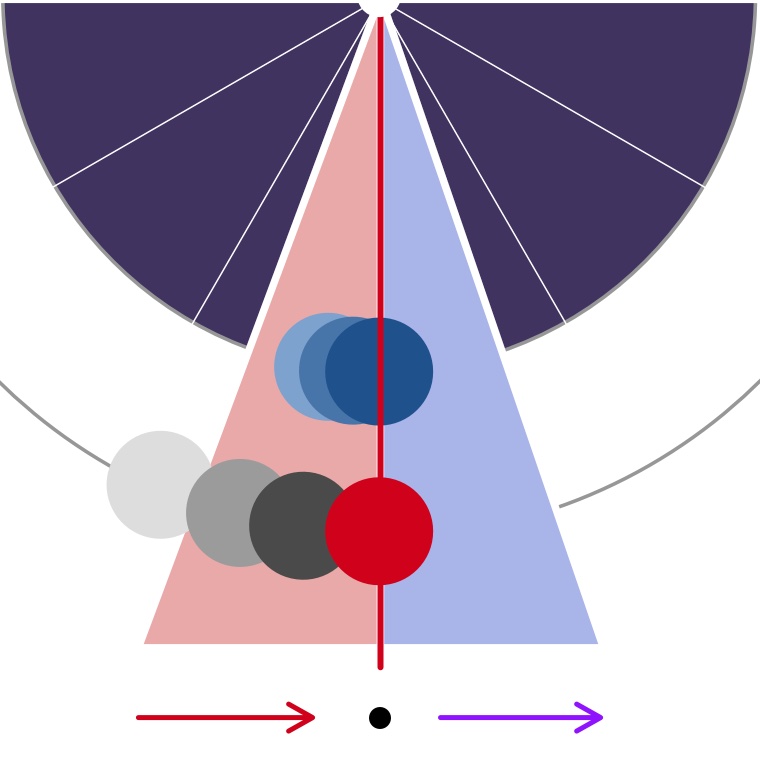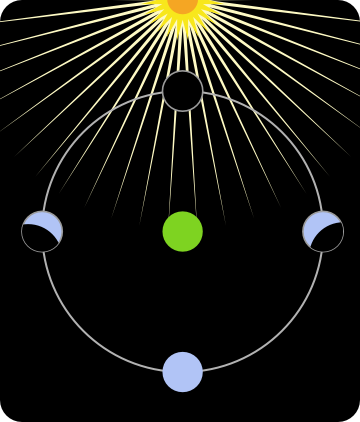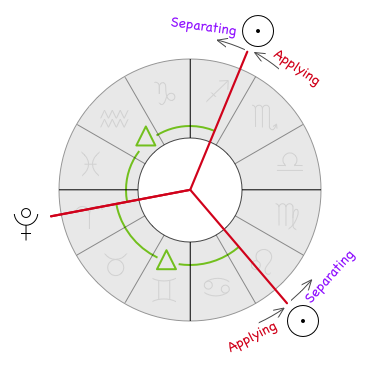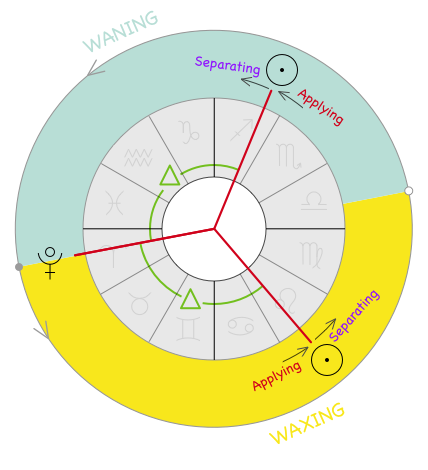Understanding planetary cycles: applying and separating aspects, part 2

Applying and separating aspects, together with waxing and waning aspects, are the building blocks of a planetary cycle that is literally just a sequence of astrological aspects.
Understanding of planetary cycles rests on the knowledge about the qualities of aspects that constitute the cycle. The first part of the story has looked into waxing and waning aspects, it this part we will extend our understanding to include applying and separating aspects.
A planetary cycle is an unfoldment of planetary dynamics between two planets. The planetary cycle starts at every conjunction and follows through the sequence of aspects until the two planets eventually arrive to their next conjunction thus marking the beginning of the next cycle. This process gives an idea of a spiral-like movement.
That is why looking at an individual aspect doesn’t necessarily provides the full picture. Any aspect between a pair of planets should be interpreted in the much broader context of the whole planetary cycle taking into account the overall symbolism of interaction between the planetary forces that are at play.
From the Moon cycle to other planets
Pretty much everybody is aware about the phases of the Moon and the lunar month that starts with the New Moon, culminates at the Full Moon and completes at the next New Moon ready for the next lunar month.

The sequence of the phases of the Moon is the planetary cycle between the Moon and the Sun. The New Moon marks the moment of conjunction between the two luminaries, the Full Moon is the moment of their opposition. The First and the Last Quarter are square aspects.
Same idea can be applied to any other pair of planets, for example:
- Mercury and Venus
- Venus and Mars
- Mars and Saturn
- Mars and Jupiter
- Saturn and Pluto, etc.
Notice that we say “Mars – Jupiter” and don’t say “Jupiter – Mars”. The order matters. The only exceptions we’ve seen are “Mars – Venus” perhaps because it reads better this way and “the Sun – Any other planet” since the Sun is the source of all planets. For every rule there is an an exception!
It is all about the speed
The topic of planetary spheres have been discussed a few times, most notably in the story about planetary hours.
The idea of planetary spheres allows us to list the planets in a certain order that reflects their astrological influence on the planet Earth:
Saturn ➝ Jupiter ➝ Mars ➝ Sun ➝ Venus ➝ Mercury ➝ Moon ➝ Earth
The Moon is the fastest moving celestial body and its influence is the strongest of all, we all have experienced that feeling of the New Moon frenzy and the silent dark void of the New Moon. Nurses at hospitals usually have good statistics about those events, after all who wants a night shift during the Full Moon?
It makes sense to arrange all planets according to the “astrological proximity” to the Earth. What could be the criteria? The only meaningful criteria is the speed of the planet as observed from the Earth. Faster planets exerts more direct force, slower planets are less direct and noticeable through their effects.
For an observant eye, the effects of Mercury and Moon are easily noticeable. The effects of slow planets like Jupiter, Saturn, Uranus, Pluto are not so immediate. The slower planets induce paradigm shifts that work at a much larger time scale, anything from a couple of years for Mars cycles to about 38 years between consucutive Saturn – Pluto conjunctions. The trans-saturnian bodies like Uranus, Neptune and Pluto move so slowly that the effects of their cycles reveal themselves only at the macro level that may span centuries.
Faster planet applies its force
For any pair of planets, there is always a faster one that “applies” its force to the planetary qualities of the slower planet and also “gathers” the qualities of the slower planet in accordance with the nature of the aspect.
This simple fact allows us, for example, to say “Venus – Saturn” and not “Saturn – Venus” aspect. The faster planet defines the dynamics of the aspect.
If we continue with the Venus and Saturn pair then for any aspect there are three phases:
- applying phase when Venus is approaching (catching up) with Saturn
- exact momentous event of the “pure aspect”
- separating phase when Venus is separating (moving away) from Saturn
Now let’s illustrate this idea using the planetary cycle between the Sun and Pluto. Being an extremely slow planet, Pluto is a good candidate because it doesn’t move too much. The Sun can form two trine aspects (120º) with the Pluto and both of those aspects will have applying and separating periods:

All other aspects behave in exactly the same manner. An aspect isn’t a specific point but rather an area around the point of exact aspect that is defined by a value called an “orb” — the maximum amount of degrees of imprecision allowed.
Looking at the whole planetary cycle
Having defined waxing/waning and applying/separating aspects, we can update the previous summary table of the Moon major aspects. The full picture emerges albeit rather complex — but don’t get overwhelmed, we’ll provide a simple illustration too!
| Phase | Aspect | Degree | Growth | Before exact | After exact |
|---|---|---|---|---|---|
| the New Moon | Conjunction | 0º | — | Waning & Applying | Waxing & Separating |
| Sextile | 60º | Waxing | Applying | Separating | |
| the First Quarter | Square | 90º | Waxing | Applying | Separating |
| Trine | 120º | Waxing | Applying | Separating | |
| the Full Moon | Opposition | 180º | — | Waxing & Applying | Waning & Separating |
| Trine | 120º | Waning | Applying | Separating | |
| the Last Quarter | Square | 90º | Waning | Applying | Separating |
| Sextile | 60º | Waning | Applying | Separating | |
| next New Moon | Conjunction | 0º | — | Waning & Applying | Waxing & Separating |
The illustration below shows a very simplified version of the planetary cycle. The cycle starts with the conjunction, waxes through several aspects to its culmination at opposition, followed by the waning period of same sequence of aspects (in reverse order) until the next conjunction. The illustration supposes the Sun – Pluto cycle that starts with the Sun being in the same position as Pluto (not illustrated but easy to figure out). The illustration doesn’t attempt to show all possible aspects — only two trines are shown, all other aspects can be presented the same way.

Some important observations:
-
Waxing/waning aspects should be understood in the context of “growth” period (first half) or “shrinking” period (second half) of the whole planetary cycle.
-
Applying/separating aspects should be understood in the context of quality of the period leading to (or away from) an exact aspect.
-
Waxing/waning quality is of a much broader period (one half of the whole planetary cycle). Applying/separating quality is of much shorter time frame, it lasts only for the duration of the aspect between two planets as defined by the aspect orb.
-
An applying aspect is traditionally considered to have a stronger influence than a separating aspect.
-
If the faster planet changed its direction — from direct to retrograde, or from retrograde to direct — that changes the quality of the aspect: an applying aspect becomes separating, and conversely, a separating aspect becomes applying. Some aspects, especially those of slower planets, may experience a number of direction changes on their way through the area of an aspect. This obviously doesn’t change the waxing/waning nature of the aspect.
Qualities of applying and separating aspects
Applying and separating aspects are better understood in the context of conjunction between two planets. An analogy with the New Moon — which is the moment of the Sun – Moon conjunction that marks the beginning of a lunar month — gives us some ideas.
An applying conjunction (ie, just before the New Moon) manifest as:
- completion of the previous project or a phase of life
- wrapping up the tasks that constitute a project or entire life
- requires judgement and precision to complete those tasks in best way possible
- preparing for the test of how well the tasks were done
- planting the seeds for the next planetary cycle
An applying conjunction brings some undertones of an hour of judgement and forces of karma. It’s a kind of a high school exam that will take the key learnings of the current planetary cycle and will apply them to the next planetary cycle… that starts with a separating conjunction.
A separating conjunction (ie, just after the New Moon) manifest as:
- freshness of energy coming out of the germinating seed
- celebration of completion
- youthfulness, joy and lightness of new beginning
Separating conjunction often highlights the achievements of past lives and starts to build the new life upon them.
A careful reader would notice that there is a similarity between waxing/waning and applying/separating processes. That is true when we look at the conjunction because a conjunction is the boundary that separates the two periods of waxing and waning processes.
All other aspects — major sextile, square, trine, opposition and numerous minor aspects — can be interpreted using the analogy of the faster planet applying its force and energy upon the slower planet.
An applying aspect is the most important time of all. The faster planet is impressing its energy upon the slower “host” planet. This is the time when the seed for the potential of success or failure are planted.
A separating aspect would exhibit the symbolism of the faster planets departing its slower “teacher” planet propelling the slower planet’s key qualities and forces toward the next aspect within the planetary cycle.
The way the interaction between the two planes will manifest itself depends on the nature of an aspect:
- a square forces manifestation and action
- an opposition is the aspect of polarity that actively seeks resolution
- a sextile is about unfoldment and opportunity
- a trine brings stimulation and resolution of conflict through an intermediary
Carefully observing qualities of a pair of planets just before and right after the aspect will give some further insights into the nature of their interaction.
A framework for aspect interpretation
Ideally, every aspect or transit should be evaluated and interpreted as a milestone of a larger planetary cycle. Only then the larger picture of what is going on in the native’s life can emerge in its fuller meaning.
Another practical point: following the Sun – Moon planetary cycle is a great learning and training habit. One can really sync their mini projects with the average 29.5 days of the Moon cycle and get a good handle as to how the events unfold: from the “youthful folly” of the separating conjunction to the “final exam” of the applying conjunction. All intermediary aspects receive additional waxing/waning qualities.
Once comfortable with the Moon cycle, extend awareness to the Mercury cycle, then to Venus, Mars, etc. In the next part we will talk about those planetary cycles.
3 Comments
Kevin Williams
Marvelous.. thanks for explaining this in this way
Candice
I thoroughly appreciate the nuanced breakdown of gaining insight and understanding of symbolism of an aspect or transit. More of THIS please! <3
Aisha
Wow. This was well written and easy to understand. Thank you!